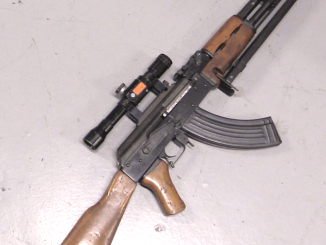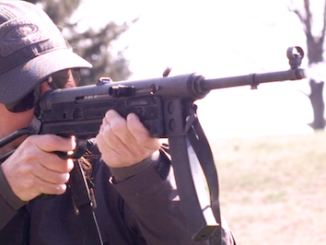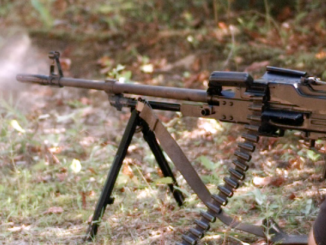Time to compare the Zastava over-sized AKs! Today I’m out at the range for a comparison shutoff between a Yugoslav M76 and a Serbian M91, both Kalashnikov-based DMRs made by the Zastava factory. The M76 is chambered for 8mm Mauser, with a pistol grip and a centerline scope. The M91 uses 7.62x54R ammunition, with a thumbhole stock and offset scope mount.
My conclusions? They both shoot the same. I like the handling of the M76 better, but as an American receiver kit-built, it just isn’t a reliable rifle. For something that can actually be counted on to run, the M91 is a much better choice.




Very interesting and useful comparison. Shot from very similar grade rifles, both cartridges perform similarly. That should tell us something.
On subject of Bolt/ Follower jam-up on M76: since follower is of machined construction, the rear side may be furnished with angular lead surface. This in connection with slight bolt lug dressing-up might, after last shot push follower down, instead of jamming on it. I cannot be certain, just guessing from what I saw in videos.
Super job Ian! You patience is admirable.
“(…)both cartridges perform similarly.(…)”
In fact they are close timeline-wise regarding bullet development.
7,62×54 R got Spitzer bullet in 1908, even back then there was perceived need for more modern cartridge (not rimmed) and it was deemed just stop-gap but as we can see proved very long lived, this bullet is now called bullet Л https://worldweapon.info/patron-762×54-r
In 1930 bullet for machine guns was developed called Д (for: long-range)
7,9×57 got Spitzer bullet in 1903, this bullet is known as S https://de.wikipedia.org/wiki/7,92_%C3%97_57_mm
In 1933 bullet for machine guns was developed called s.S. (for: heavy Spitzer)
Around 1930 there were a number of armies that introduced heavy bullets for long machine gun use. Apart from the Soviet D, there were the U.S. M1 and the French 8 mm 32N and 7.5 mm 33D, for example.
The German sS cartridge was already produced late in WW1 for this purpose. In 1930 it was decided to make it standard issue also for the rifle, like the U.S. M1 was.
“(…)at the range for a comparison shutoff between a Yugoslav M76 and a Serbian M91(…)”
What does shutoff mean here? It is very intricate pun I do not undestand?
I think it was supposed to be “Shootout” but probably got autocorrected.
The AK family and the CETME/G3 family are both foreign made stamped-steel guns with loose interior clearances, intended for huge volumes of deployment with low cost per unit, both traditionally lacking in bolt holdopen, both considered extremely rugged but decidedly backwards in terms of modern ergonomics, and both regarded as very reliable in their original mass-produced military spec guise. In both cases, geometry is very similar despite the vast differences in operating principle, with the bolt carrier riding beneath a recoil spring on a guiderod that extends through an action tube that rides over and in front of the bolt head, both bolt heads lock into a trunnion made of solid metal that is pinned into the head of the stamped receiver.
I wonder why it is, then, that despite so many similarities, US-made AK receivers are always so heinous, but US-made CETME family receivers like the PTR can be counted on basically like the originals.
I don’t think it’s general build quality, because Century used PTR receivers in their last batch of parts-kit CETMEs. Century is not known for their exquisite build quality, for good reason, but despite this the C308 persists as an extremely reliable .308 platform with *minimal* tuning by the end user, generally consisting of running some steel wool down the inside of the cocking tube with a set of angled forceps, using a Dremel with a grinding stone to quickly true the ears of the trunnion with the frame rails to prevent bolt head preengagement, and then replacing the C-pin holding the head of the recoil rod in with a McMaster-Carr stainless roll pin, all for a total of about $10 and about fifteen minutes of work including cleanup at the end.
Is it fair to say US-made AKs suffer from essentially the same problems, and that it’s just not as practical to perform these “touch up” fixes as it is on an HK91 clone? Or is there something different about the AK that for some reason just makes it difficult to make in the US?
Interesting question, though peripheral to this video (M76 is milled).
I’ve never worked with an HK-type receiver and have only worked with Saiga AK receivers (both flawless). In principle, the AKM receiver should be much easier to get right, with basically infinite adjustability in four rails that are stamped oversize and can each be bent or filed (even repositioned in the case of the bottom two), whereas HKs’ indentation rails would need to be stamped and bent just-right the first time. I don’t know what else to tell you, other than kudos to PTR’s QA program.
I have seen several videos from production line in Izhevsk plant. Final assembly operations are performed by hand in fixtures; it takes some well trained touches to make good rifle.
This is just completely off the top of my head, so take it for what it’s worth.
Given the complexity of G3/CETME receiver stampings, it wouldn’t surprise me if they were done with surplus HK dies, purchased maybe from one of the countries that built the G3 under license. AK receiver stamping jigs, in contrast, seem much more improvised that what’s used in Izhevsk. So while an AK receiver is much simpler, most US receivers are being built on less precise equipment than that used for US G3/CETME receivers.
As is said a lot around here, I could be wrong.
The PTR clones are made with old tooling from the FMP factory that manufactured udner license for the armed forces of Portugal. Other clone sellers in the US use turkish or pakistani made receivers. Then there are a few gunsmiths that bend the sheet metal manually. I guess the market is so small, that only the most dedicated and skilled do it.
Whereas anything AK has the stigma of being cheap attached. Ignoring, that lots of AK were sold under value in the past, because there were so many of them (just like with WW1 and 2 surplus rifles. A Mosin-Nagant is anything but cheap to make new actually). An AK is only cheap when made in a big factory that puts out millions of them, whcih spreads out the costs over high numbers. When made in low numbers it gets expensive. A quality made AK rifle costs as much as an AR-15 type rifle made by a competent shop, if not more, because the basic parts for an AR-15 are ubiquitous. For an AK you have to make many parts yourself or somehow import them from Russia, Bulgaria etc. so to keep the cheap price, because many buyers are not going to see it worth it to buy an expensive AK corners are being cut. Plus a lack in expertise in making AKs.
To save that poor M76 parts kit build it would need either a competent gunsmith fidning the problem areas and correcting these or putting the parts in a properly made receiver, that is correctly dimensioned and assembled from the start.
It would be interesting to find out what exactly cause the reliability issues. Perhaps some things that can be easily adjusted, or perhaps not. The mechanics and physics of the failures need to be determined.
does nodak spud make appropriate receivers for these rifles?
Tortort does & I have had 100% function & quality from their recivers ( plural!!). Thought C&C Warrior, Nodac & an Ohio guy did make them , I know Torttort still make them . All Torttort are high quality I have worked with
The “correct” M76 with the “right” cartridges confidently holds accuracy of about 1 MOA.
“Even” being a barrel replacement at 308.
Most likely, the problem is in the “right” gunsmiths.
As in all old AKs, for proper operation, the bolt must be adjusted individually for the receiver.
Even if the new receiver was made according to the original drawings, the bolt was ALREADY fitted to the old receiver.
Of course, there is no need to talk about any accuracy and reliability.
Similarly for the M91.
When the old locksmiths who engaged in manual fitting of bolts ended in the 199s at the arms factories, AK-s abruptly ceased to be “the most reliable.”
Apparently, the same thing happened with the Serbs.
These two sticks are facing each other.
Suitable only as a paddle for a raft. LOL
What distance ? Not that bad for your ammo. I shot PPY match in a TIGR at 200 meters with a lot of unpleasant recoil and poor results. I load light loads with a 150 grains bullet made for the Lee Enfield with very good results
I use a wax applied with a q-tip on both front and rear of the M-76 magazines which seems to work great on preventing the mag’s follower from tilting. An application of a light grease also will help on the front of the mags forward wall. Works for me.
My M76 was built on a good receiver by a guy who knows his business. There have been no problems with this rifle in the twelve or so years I’ve owned it. I did put in a Red Star trigger group, but it really didn’t need it. With Yugoslavian ammunition specifically made for the rifle it does 1 1/2 MOA at a hundred and I really like it. A nice rifle to have. And the scope is decent enough.
While both rifles are capable, the M91 tends to have better slope run accuracy due to its design and the characteristics of the 7.62x54R cartridge. If precision and reliability are priorities, the M91 is often preferred, especially in competitive or tactical scenarios.